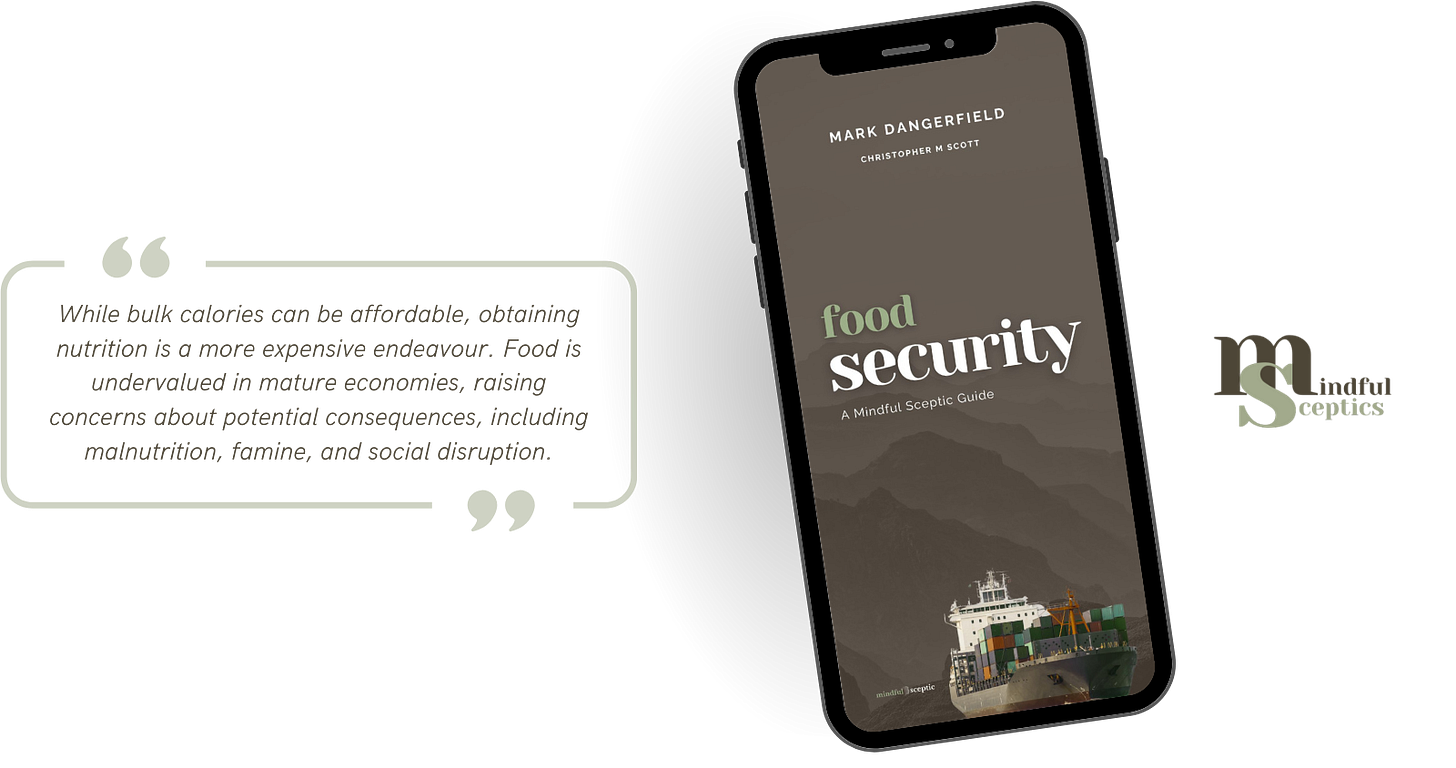Core Idea
Food security experts speak of four neat pillars applied to food. They are availability, access, utility, and stability. These pillars are used to explain why people go hungry in a world that produces enough food for everyone, because they lack one or more of the pillars.
The framework sounds sensible, even humanitarian.
Only here is the reality.
We grow enough calories to feed 8 billion people, yet 4 billion remain malnourished.
The experts tell us this is a distribution problem, not a production problem. This comforting narrative suggests we simply need better logistics, fairer markets, and more efficient supply chains.
The implication is also clear… we’re on the right track, just need to fine-tune the system.
The four-pillar framework has become the accepted wisdom among policymakers, aid organisations, and development economists.
It makes hunger sound like a technical problem with technical solutions.
Counterpoint
The four-pillar framework is intellectually appealing, but it systematically obscures the reality that our global food system is designed to create scarcity alongside abundance.
The framework treats symptoms while protecting the disease.
Consider what the pillars actually describe. “Availability” means there’s food somewhere in the world. “Access” means you can afford it if you have money. “Utility” means you can digest it if it’s nutritious. “Stability” means it continues if you’re lucky.
Notice what’s missing? There is a pressing question of why 4 billion people lack access to adequate nutrition in the first place. And before your mind wanders, not all of these 4 billion live in Africa or the impoverished regions of Asia and Latin America. Some live in your town, perhaps even your street.
The thing is that pillars present hunger as a natural variation around a fundamentally sound system. They don’t ask why cheap calories come from grains, sugar, and seed oils that make people sick. They don’t question why nutritious food is expensive while processed food is subsidised. They don’t examine why volatile commodity markets determine who eats and who starves.
The framework’s real function is to legitimise the existing system by making hunger seem like an accident rather than an inevitable outcome.
It allows policymakers to feel virtuous while maintaining structures that guarantee malnutrition for billions. We might say that the four pillars—availability, access, utility, and stability—are not pillars at all but walls that keep uncomfortable truths from view.
Thought Challenge
Map the food security of ten families you know across the four pillars. Include wealthy families and struggling ones. Notice how the pillars describe their situations but do not explain why such disparities exist or persist.
Next, calculate what percentage of your income goes to food, then compare this to the percentage for someone earning minimum wage in your area. The four pillars will describe their different situations identically—as problems of “access” and “utility”—while hiding the systemic inequality that creates these differences.
Closing Reflection
Real food security analysis would start with different questions…
Why does a system that produces enough food for everyone systematically deny nutrition to half the population?
Why are the most calorie-dense foods the least nutritious?
Why do we accept that access to adequate nutrition depends on purchasing power rather than human need?
The four-pillars framework serves the same function as separate water fountains once did, maintaining systematic exclusion while providing a respectable vocabulary to describe it.
Until we acknowledge that our food system creates hunger by design, we’ll keep polishing the pillars while people starve.
Evidence Support
FAO, IFAD, UNICEF, WFP & WHO. (2023). The State of Food Security and Nutrition in the World 2023. FAO.
TL;DR… annual flagship report provides a thorough overview of global hunger, emphasising that food insecurity is primarily due to issues of access, affordability, and conflict rather than total food scarcity. The report documents how enough food is produced globally to feed everyone, but economic and political barriers consistently prevent equitable access, leading to persistent hunger and malnutrition.
Relevance to the insight… synthesises global data showing persistent, widespread food insecurity despite rising food production, directly attributing hunger to inequality in distribution, accessibility, and persistent structural vulnerabilities within food systems. It is regularly cited by academics and policymakers as the authoritative summary of global food security challenges.
Clapp, J., & Moseley, W. G. (2020). This food crisis is different: COVID-19 and the fragility of the neoliberal food security order. Journal of Peasant Studies, 47(7), 1393-1417.
TL;DR… how COVID-19 exposed the structural fragility of a globalised food system, demonstrating that food insecurity during the pandemic was driven by distribution bottlenecks, loss of income, and inequality rather than any worldwide shortage of food. The authors argue that neoliberal policies reinforce barriers to access for vulnerable populations, resulting in “entitlement failures.”
Relevance to the insight… empirically shows that the breakdown in food security during recent crises arises from economic and political failures in distribution, not from a literal lack of food. This supports the idea that the “pillars” of access and utilisation are neglected even as production (“availability”) is abundant.
Sen, A. (1981). Poverty and Famines: An Essay on Entitlement and Deprivation. Oxford University Press.
TL;DR… famine and mass hunger almost always occur not because of a scarcity of food, but because of failures in distribution, entitlement, and access. Sen’s “entitlement approach” shifts the focus from aggregate food availability to the socio-economic mechanisms that determine individuals’ ability to access food.
Relevance to the insight… underpins contemporary food security theory, explicitly referenced in the conceptualisation of the four pillars, and provides rigorous evidence that correcting inequality in food access, rather than simply increasing production, is key to addressing global hunger and malnutrition.
HLPE (High Level Panel of Experts on Food Security and Nutrition). (2020). Food Security and Nutrition: Building a Global Narrative towards 2030. HLPE Report 15. Committee on World Food Security.
TL;DR… food security challenges are primarily distributive: poverty, instability, and weak safety nets leave billions food insecure, even as global food supplies are ample. The report underscores that resolving hunger and malnutrition in the 21st century requires action on equity, resilience, and justice in food system governance as much as on productivity.
Relevance to the insight… authoritative status and global evidence base, this report strengthens the insight that the four pillars framework demands addressing access and utilisation—structural and systemic issues—since focusing solely on availability cannot end global food apartheid.






